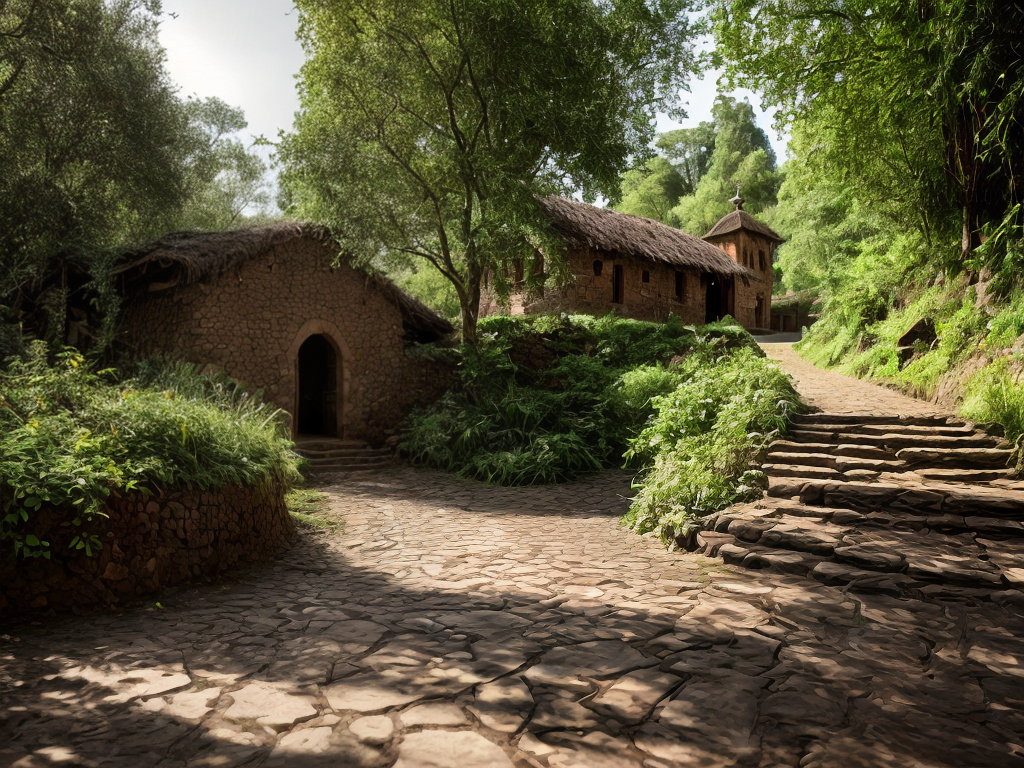Oh boy, do I have an adventure for you! If you’re up for exploring the stunning wonders of Lalibela, then hop on board because I’ve got the ultimate guide to overland travel. From the best time to visit to choosing your mode of transportation, I’ve got you covered. Get ready to immerse yourself in the rich history, breathtaking landmarks, and vibrant culture of Lalibela. Let’s hit the road and make memories that will last a lifetime!
Best Time to Visit
The best time to visit Lalibela is during the dry season. The dry season, which runs from October to March, offers the most favorable weather conditions for exploring this ancient Ethiopian town. With clear skies and minimal rainfall, visitors can enjoy the stunning rock-hewn churches and breathtaking landscapes without any hindrances. During this time, the temperatures are also pleasant, ranging from 20 to 25 degrees Celsius, making it comfortable for outdoor activities and sightseeing. The dry season is also the peak tourist season, so expect larger crowds and higher prices. However, the bustling atmosphere adds to the overall experience, and the beauty of Lalibela is not diminished. If you want to make the most of your visit to Lalibela, plan your trip during the dry season for the best weather conditions and an unforgettable journey.
Choosing Your Mode of Transportation
When deciding how to get around Lalibela, it is important to consider the various modes of transportation available. The two main options are overland travel and air travel. Overland travel allows you to experience the stunning landscapes and immerse yourself in the local culture. It offers the opportunity to visit more remote areas and stop at interesting sights along the way. However, it can be time-consuming and uncomfortable, especially if you are not used to long journeys on rough roads. On the other hand, air travel is much quicker and more convenient. It saves time and allows you to cover more ground in a shorter period. However, it can be more expensive and you may miss out on the unique experiences that overland travel offers. Ultimately, the choice depends on your preferences, budget, and time constraints.
Essential Travel Documents and Permits
When it comes to traveling to Lalibela, having the right travel documents and permits is essential. From passports to visas, there are certain documents that are required for entry into the country. Additionally, certain areas in Lalibela may require special permits, so it’s important to be aware of these and obtain them beforehand.
Required Travel Documents
To enter Lalibela by land, I must have essential travel documents and permits. The first requirement is a valid passport with at least six months of validity remaining. Additionally, a visa is required for most travelers visiting Ethiopia. The visa application process can be done online or at the Ethiopian embassy or consulate in your home country. It is important to check the specific visa requirements for your nationality before traveling. Another important document to consider is travel insurance. While not mandatory, having travel insurance is highly recommended to protect yourself against unexpected medical expenses or trip cancellations. It is advisable to have comprehensive coverage that includes emergency medical assistance and evacuation. Here is a table summarizing the essential travel documents and permits required for visiting Lalibela:
| Document | Requirement |
|---|---|
| Passport | Valid passport with at least 6 months validity |
| Visa | Required for most travelers; check specific requirements for your nationality |
| Travel Insurance | Highly recommended for medical expenses and trip cancellations |
Having these documents in order will ensure a smooth and hassle-free journey to Lalibela.
Permits for Specific Areas
I frequently obtain permits for specific areas as part of my essential travel documents and permits when traveling to Lalibela by land. These permits are necessary to gain special access to certain restricted areas in Lalibela. Here are some important points to keep in mind when applying for permits:
- Apply in advance: Permits for restricted areas must be obtained before your visit. It is recommended to apply well ahead of time to ensure a smooth travel experience.
- Provide necessary documentation: Be prepared to provide identification, travel itinerary, and any other required documents when applying for permits.
- Pay attention to restrictions: Each permit has specific rules and regulations. It is important to familiarize yourself with these restrictions to avoid any issues during your visit.
- Follow the guidelines: Respect the guidelines set by the authorities while exploring the restricted areas. This will help preserve the cultural and historical significance of these sites.
- Plan accordingly: Take into account the time it may take to obtain permits when planning your trip to Lalibela. This will help you avoid any last-minute complications.
Planning Your Itinerary
During my journey to Lalibela by land, I carefully crafted my itinerary to maximize my time and experience in this historic Ethiopian town. Itinerary customization and budget planning were crucial in ensuring a smooth and enjoyable trip. To help me organize my schedule and expenses, I created a table outlining my activities and estimated costs:
| Day | Activities | Estimated Cost (USD) |
|---|---|---|
| 1 | Visit Lalibela Rock-Hewn Churches | $50 |
| 2 | Explore the Lalibela Market | $20 |
| 3 | Hike to Asheton Maryam Monastery | $30 |
| 4 | Take a traditional Ethiopian cooking class | $40 |
Exploring Lalibela’s Landmarks and Attractions
When it comes to exploring Lalibela, there are three key points that cannot be missed: the must-visit holy sites, the hidden architectural wonders, and the local cultural experiences. From the rock-hewn churches of Lalibela, a UNESCO World Heritage Site, to the stunning monolithic structures carved out of solid rock, there is a wealth of religious and architectural significance to discover. Additionally, immersing oneself in the vibrant local culture, whether through traditional music and dance or by visiting local markets and interacting with the friendly locals, is an essential part of truly experiencing Lalibela’s rich heritage.
Must-Visit Holy Sites
Exploring Lalibela’s holy sites is an enlightening journey through ancient landmarks and sacred attractions. The town of Lalibela is renowned for its rock-hewn churches, which are not only architectural marvels but also important pilgrimage sites for Ethiopian Orthodox Christians. Here are some must-visit holy sites in Lalibela:
- Bete Giyorgis: Also known as the Church of St. George, it is the most iconic and well-preserved of all the rock-hewn churches in Lalibela.
- Bete Medhane Alem: This church is the largest monolithic rock-hewn church in the world and is believed to be the final resting place of King Lalibela.
- Bete Maryam: Dedicated to the Virgin Mary, this church is known for its beautifully decorated frescoes.
- Bete Abba Libanos: This church is famous for its intricate carvings and its connection to the legendary Lalibela himself.
- Bete Emmanuel: This church is known for its unique architecture and is often used for religious ceremonies and rituals.
Visiting these holy sites allows you to immerse yourself in the rich history, religious traditions, and spiritual significance of Lalibela.
Hidden Architectural Wonders
As I delve into Lalibela’s hidden architectural wonders, I am captivated by the unique landmarks and attractions that reveal the rich craftsmanship and ingenuity of this historic town. Lalibela is filled with hidden gems and ancient secrets, waiting to be discovered by intrepid travelers like myself. One of the most remarkable attractions is the Church of St. George, also known as Bete Giyorgis. This monolithic church is carved entirely out of rock and is a testament to the incredible skill of the ancient craftsmen. Another must-visit site is the Church of St. Mary, or Bete Maryam, which is famous for its intricate stone carvings and beautiful frescoes. The Rock-Hewn Churches of Lalibela are truly architectural wonders, and exploring their hidden beauty is an experience like no other.
| Landmarks & Attractions | Description |
|---|---|
| Church of St. George (Bete Giyorgis) | A monolithic church carved out of rock, showcasing exceptional craftsmanship. |
| Church of St. Mary (Bete Maryam) | Known for its intricate stone carvings and stunning frescoes. |
| Rock-Hewn Churches of Lalibela | A collection of 11 churches carved into the mountainside, each with its own unique design and history. |
| Bet Medhane Alem | The largest rock-hewn church in Lalibela, featuring beautiful architectural details and religious artifacts. |
Local Cultural Experiences
As I continue my exploration of Lalibela’s hidden architectural wonders, I am eager to delve into the local cultural experiences offered by the town’s landmarks and attractions. Lalibela is not only known for its magnificent rock-hewn churches, but also for its rich cultural heritage. Here are some of the local cultural experiences you can enjoy:
- Witness traditional rituals performed by the local community, such as the Timkat festival, a vibrant celebration of Epiphany.
- Immerse yourself in the captivating sounds and rhythms of traditional music and dance, which are an integral part of Lalibela’s cultural identity.
- Visit the local markets and witness the bustling atmosphere, where vendors sell traditional crafts, textiles, and spices.
- Engage with the friendly locals and learn about their customs, traditions, and way of life.
- Participate in a traditional coffee ceremony, a symbol of Ethiopian hospitality, where coffee is roasted, brewed, and served with great care and ceremony.
These cultural experiences will provide you with a deeper understanding and appreciation of Lalibela’s unique heritage.
Safety Tips and Cultural Etiquette
To ensure a safe and respectful journey, it is important to be aware of safety tips and cultural etiquette when traveling overland to Lalibela. When it comes to safety precautions, it is advisable to always carry a first aid kit and be prepared for any medical emergencies that may arise during the journey. Additionally, it is crucial to stay informed about the current political situation and any travel advisories. As for cultural etiquette, it is essential to respect the traditional customs of the local people. This includes dressing modestly, especially when visiting religious sites, and asking for permission before taking photographs of individuals or sacred places. By following these safety tips and cultural etiquette, travelers can ensure a smooth and enjoyable experience while exploring Lalibela by land.







